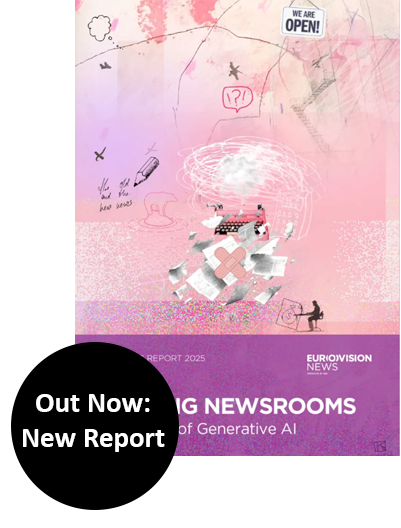Every year Nieman Lab at Harvard University asks journalists and journalism researchers around the globe about trends in the industry and what they predict for the year to come. This is what I envisioned for 2020:
News deserts were yesterday. In the year to come, journalism will rediscover the communities it’s meant to serve.
Several factors will contribute to this. One is the ever more urgent need for media organizations to engage with real people in the real world. Journalism has to regain the trust of the citizens it’s made for. And trust develops best through direct engagement. It works particularly well if you can see that the person on the other side is a human being like yourself, making an honest effort to do a difficult, sometimes risky job that’s not even tremendously lucrative.
The other factor is that international journalism has become a winner-take-all environment. For a while, everyone was enthralled with The New York Times and its progress in growing revenue through digital subscriptions, or The Washington Post with its reputation for being at the forefront of tech innovation. But the glamour has worn off. Now even comparatively big news organizations have realized that their successes are not replicable. They’re not the Times or the Post; they can’t build an international audience and invest in all the tech others are craving for. They have come to understand that there’s no one-size-fits-all solution — just bits and pieces one can adapt to one’s own needs.
The way forward is to make the best use of the unique position each organization finds itself in. And in many cases, this is the local environment. It’s the place where your audience lives that you’re best equipped to listen to, to engage with, and to serve — the citizens whose lives you can have a real impact on. It’s the place for community building, for creating shared debates and experiences.
While many traditional local news organizations are still struggling for a lack of revenues and resources, there’s also some hope that the act of serving one’s communities will become easier and cheaper if the right approaches are used. First, within the over-abundance of information, it becomes more and more acceptable to focus on what one can do best and leave out the rest. Modern news organizations don’t have to be “the paper of record” any longer, because people are recording everything all the time and search engines help them to find much of the information they need anyway. Consequently, local newsrooms can afford to develop strategies that center around the needs of their audiences.
Second, there are now more formats than ever available to help to build a relationship with these audiences, from newsletters or podcasts with a personal touch to reader events. Some of these formats also help new market entrants: news startups that don’t have to launch as a full-blown effort with a large newsroom, but maybe start instead with a newsletter that builds engagement and loyalty.
Thirdly, there will be AI-solutions and automated news production to cater to the appetite for data-based, locally relevant stories, like the development of real estate prices or updates of local weather forecasts. Fourthly, we will see a lot of investments along these lines, particularly since big players like Google and Facebook have also discovered local markets as grounds for support, so have foundations.
Hopefully, the focus on local journalism will also bring more talent back into the equation. The future of journalism will be in unique quality reporting and research. A generation of young journalists was raised in front of computer screens, copying and pasting stories for quick successes in clicks and reach. Now many are savvy in SEO and a variety of storytelling formats. But this prevented them from learning the ropes of doing in-depth investigations. Those require patience, persistence, and communication skills, because they’re about building trust with sources. Picking up the phone and meeting people away from the office might experience a revival. By the way, a video is best shot at the scene, not at the desk.
A new focus on local journalism will bring it back to its core. Let the international winners grab the high-hanging fruit. The low-hanging ones could be right there in front of your doorstep.
This text was published by Nieman Lab on January 3, 2020




OXFORD – Depending on where you get your news, your view of how the impeachment inquiry into US President Donald Trump is unfolding may be very different from that of your friends, relatives, or neighbors. You may also think that any version of the story that conflicts with yours is simply untrue. This lack of consensus on basic facts – largely a byproduct of social media – carries serious risks, and not nearly enough is being done to address it.
In recent years, the need to improve “media literacy” has become a favorite exhortation of those seeking to combat misinformation in the digital age, especially those who would prefer to do so without tightening regulation of tech giants like Facebook and Google. If people had enough media savvy, the logic goes, they would be able to separate the wheat from the chaff, and quality journalism would prevail.
There is some truth to this. Just as it is dangerous to drive in a place where you don’t know the traffic laws, navigating the new digital-media environment safely – avoiding not only “fake news,” but also threats like online harassment, nonconsensual (“revenge”) porn, and hate speech – requires knowledge and awareness. Robust efforts to improve media literacy globally are thus crucial. Free, credible, and independent news media are a pillar of any functioning democracy, essential to enable voters to make informed decisions and to hold elected leaders accountable. Given this, media literacy must be pursued within a broader campaign to improve democratic literacy.
Since its invention in ancient Greece more than 2,500 years ago, democracy has depended on rules and institutions that strike a balance between participation and power. If the point was simply to enable everyone to speak up, platforms like Facebook and Twitter would be the pinnacle of democracy, and popular movements like the 2011 Arab Spring would naturally produce functioning governments.
Instead, the objective is to create a system of governance in which elected leaders bring to bear their knowledge and experience, in order to advance the interests of the people. The rule of law and the separation of powers, guaranteed by a system of checks and balances, are vital to the functioning of such a system. In short, mobilization means little without institutionalization.
And yet, today, public institutions are suffering from the same lack of trust as news media. To some extent, this is warranted: many governments have failed to meet their citizens’ needs, and corruption is rampant. This has fueled rising skepticism toward democratic institutions, with people often preferring ostensibly more egalitarian online platforms, where everyone’s voice can be heard.
The problem is that such platforms lack the checks and balances that informed decision-making demands. And, contrary to the early expectations of some Internet pioneers, those checks and balances will not emerge organically. On the contrary, tech companies’ algorithm-driven business models all but preclude them, because they amplify voices according to clicks and likes, not value or veracity.
Populist politicians have taken advantage of the lack of checks and balances to obtain power, which they often use to please their supporters, ignoring the needs of opponents or minority groups. This type of majority rule looks a lot like mob rule, with populist leaders trying to overrule legislatures and courts to fulfill the desires – often shaped by lies and propaganda – of their constituents. British Prime Minister Boris Johnson’s recent attempt to suspend Parliament, in order minimize its ability to prevent a no-deal Brexit, is a case in point.
In a democracy, all people must be able to trust their leaders to uphold their rights and protect their basic interests, regardless of whom they voted for. They should be able to go about their daily lives, confident that public officials will dedicate their time and energy to making informed decisions – and that those who don’t will be checked and balanced by the rest. Credible independent media support this process.
In Johnson’s case, the judiciary fulfilled its duty to check the executive. But with every assault on democratic institutions, accountability is weakened, people become more disillusioned, and the legitimacy of the system declines. Over time, this reduces the incentive for talented people to work in fields like journalism and politics, eroding their effectiveness and legitimacy further.
Breaking this vicious circle requires the rapid expansion of media and democratic literacy, including how the system works and who owns and shapes it. And yet, as a forthcoming study by the Council of Europe’s Expert Committee on Quality Journalism in the Digital Age (on which I served) shows, most existing media-literacy programs are limited to teaching schoolchildren how to use digital platforms and understand news content. Very few target older people (who are most in need), explain who controls media and digital infrastructure, or teach the mechanisms of algorithmic choice.
Democracies all over the world are enduring a stress test. If they are to pass, their institutional underpinnings must be reinforced. That requires, first and foremost, an understanding of what those underpinnings are, why they matter, and who is trying to dismantle them.
This commentary was published by Project Syndicate on November 28, 2019